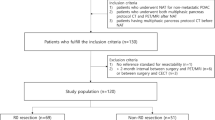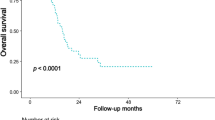Abstract
Purpose
This study aimed to assess the value of 18F-FDG PET/CT and carbohydrate antigen 19-9 (CA 19-9) levels in predicting lymph node micrometastases in patients with pancreatic cancer.
Patients and methods
A total of 160 patients with pancreatic carcinoma were included in the study from 2012 to 2017. All patients underwent surgical treatment and PET/CT scans as well as tests to measure CA 19-9 levels before surgery. The PET/CT scans were evaluated by 2 nuclear medicine physicians who were blinded to the clinical information and were compared to the postsurgical pathological findings. Logistic regression analysis was performed to determine the variables that could predict lymph node micrometastases. Receiver operating characteristic (ROC) curves were utilized to find the best cutoff value of the variables related to predicting lymph node micrometastases.
Results
The maximum standardized uptake value (SUVmax) of the primary tumor and CA 19-9 level were potent predictors for determining the lymph node status. The best SUVmax and CA 19-9 cutoff values for predicting lymph node micrometastases were 7.05 (sensitivity = 71.2%, specificity = 76.6%) and 240.55 U/ml (sensitivity = 62.1%, specificity = 79.8%), respectively.
Conclusion
Patients with pancreatic cancer with a tumor SUVmax ≥ 7.05 or a CA 19-9 value ≥ 240.55 are likely to have lymph node micrometastases.


Similar content being viewed by others
References
Siegel RL, Miller KD, Jemal A. (2015) Cancer statistics, 2015. CA CANCER J CLIN 65:5-29
Roland CL, Yang AD, Katz MH, Chatterjee D, Wang H, Lin H, Vauthey JN, et al. (2015) Neoadjuvant therapy is associated with a reduced lymph node ratio in patients with potentially resectable pancreatic cancer. ANN SURG ONCOL 22:1168-1175
Fink DM, Steele MM, Hollingsworth MA. (2016) The lymphatic system and pancreatic cancer. CANCER LETT 381:217-236
Xiao Z, Luo G, Liu C, Wu C, Liu L, Liu Z, Ni Q, et al. (2014) Molecular mechanism underlying lymphatic metastasis in pancreatic cancer. BIOMED RES INT 2014:925845
Artinyan A, Anaya DA, McKenzie S, Ellenhorn JD, Kim J. (2011) Neoadjuvant therapy is associated with improved survival in resectable pancreatic adenocarcinoma. CANCER-AM CANCER SOC 117:2044-2049
Mokdad AA, Minter RM, Zhu H, Augustine MM, Porembka MR, Wang SC, Yopp AC, et al. (2016) Neoadjuvant Therapy Followed by Resection Versus Upfront Resection for Resectable Pancreatic Cancer: A Propensity Score Matched Analysis. J CLIN ONCOL. 35:515-522
Sun H, Zhou J, Liu K, Shen T, Wang X, Wang X. (2019) Pancreatic neuroendocrine tumors: MR imaging features preoperatively predict lymph node metastasis. ABDOM RADIOL (NY) 44:1000-1009
Abdel RA, Elkammary S, Elmorsy AS, Elshafey M, Elhadedy T. (2011) Characterization of mediastinal lymphadenopathy with diffusion-weighted imaging. MAGN RESON IMAGING 29:167-172
Abdel RA, Gaballa G. (2011) Role of perfusion magnetic resonance imaging in cervical lymphadenopathy. J COMPUT ASSIST TOMOGR 35:21-25
Lee JH, Han SS, Hong EK, Cho HJ, Joo J, Park EY, Woo SM, et al. (2019) Predicting lymph node metastasis in pancreatobiliary cancer with magnetic resonance imaging: A prospective analysis. EUR J RADIOL 116:1-7
Kim R, Prithviraj G, Kothari N, Springett G, Malafa M, Hodul P, Kim J, et al. (2015) PET/CT Fusion Scan Prevents Futile Laparotomy in Early Stage Pancreatic Cancer. CLIN NUCL MED 40:e501-e505
Rijkers AP, Valkema R, Duivenvoorden HJ, van Eijck CH. (2014) Usefulness of F-18-fluorodeoxyglucose positron emission tomography to confirm suspected pancreatic cancer: a meta-analysis. EUR J SURG ONCOL 40:794-804
Zhang J, Zuo CJ, Jia NY, Wang JH, Hu SP, Yu ZF, Zheng Y, et al. (2015) Cross-modality PET/CT and contrast-enhanced CT imaging for pancreatic cancer. WORLD J GASTROENTEROL 21:2988-2996
Jiang XT, Tao HQ, Zou SC. (2004) Detection of serum tumor markers in the diagnosis and treatment of patients with pancreatic cancer. HEPATOBILIARY PANCREAT DIS INT 3:464-468
Wu L, Huang P, Wang F, Li D, Xie E, Zhang Y, Pan S. (2015) Relationship between serum CA19-9 and CEA levels and prognosis of pancreatic cancer. ANN TRANSL MED 3:328
Boeck S, Stieber P, Holdenrieder S, Wilkowski R, Heinemann V. (2006) Prognostic and therapeutic significance of carbohydrate antigen 19-9 as tumor marker in patients with pancreatic cancer. ONCOLOGY 70:255-264
Nakagawa T, Yamada M, Suzuki Y. (2008) 18F-FDG uptake in reactive neck lymph nodes of oral cancer: relationship to lymphoid follicles. J NUCL MED 49:1053-1059
Riediger H, Keck T, Wellner U, Zur HA, Adam U, Hopt UT, Makowiec F. (2009) The lymph node ratio is the strongest prognostic factor after resection of pancreatic cancer. J GASTROINTEST SURG 13:1337-1344
La Torre M, Cavallini M, Ramacciato G, Cosenza G, Rossi DMS, Nigri G, Ferri M, et al. (2011) Role of the lymph node ratio in pancreatic ductal adenocarcinoma. Impact on patient stratification and prognosis. J SURG ONCOL 104:629-633
Razek A, Elfar E, Abubacker S. (2019) Interobserver agreement of computed tomography reporting standards for chronic pancreatitis. ABDOM RADIOL (NY) 44:2459-2465
Im HJ, Oo S, Jung W, Jang JY, Kim SW, Cheon GJ, Kang KW, et al. (2016) Prognostic Value of Metabolic and Volumetric Parameters of Preoperative FDG-PET/CT in Patients With Resectable Pancreatic Cancer. MEDICINE (BALTIMORE) 95:e3686
Barugola G, Partelli S, Marcucci S, Sartori N, Capelli P, Bassi C, Pederzoli P, et al. (2009) Resectable pancreatic cancer: who really benefits from resection? ANN SURG ONCOL 16:3316-3322
Ferrone CR, Finkelstein DM, Thayer SP, Muzikansky A, Fernandez-delCastillo C, Warshaw AL. (2006) Perioperative CA19-9 levels can predict stage and survival in patients with resectable pancreatic adenocarcinoma. J CLIN ONCOL 24:2897-2902
Crippa S, Salgarello M, Laiti S, Partelli S, Castelli P, Spinelli AE, Tamburrino D, et al. (2014) The role of (18)fluoro-deoxyglucose positron emission tomography/computed tomography in resectable pancreatic cancer. Dig Liver Dis 46:744-749
Asagi A, Ohta K, Nasu J, Tanada M, Nadano S, Nishimura R, Teramoto N, et al. (2013) Utility of contrast-enhanced FDG-PET/CT in the clinical management of pancreatic cancer: impact on diagnosis, staging, evaluation of treatment response, and detection of recurrence. PANCREAS 42:11-19
Kim MJ, Lee KH, Lee KT, Lee JK, Ku BH, Oh CR, Heo JS, et al. (2012) The value of positron emission tomography/computed tomography for evaluating metastatic disease in patients with pancreatic cancer. PANCREAS 41:897-903
Author information
Authors and Affiliations
Corresponding author
Ethics declarations
Conflict of interest
The authors have declared that there are no conflicts of interest.
Additional information
Publisher's Note
Springer Nature remains neutral with regard to jurisdictional claims in published maps and institutional affiliations.
Rights and permissions
About this article
Cite this article
Wang, S., Shi, H., Yang, F. et al. The value of 18F-FDG PET/CT and carbohydrate antigen 19-9 in predicting lymph node micrometastases of pancreatic cancer. Abdom Radiol 44, 4057–4062 (2019). https://doi.org/10.1007/s00261-019-02248-0
Published:
Issue Date:
DOI: https://doi.org/10.1007/s00261-019-02248-0




